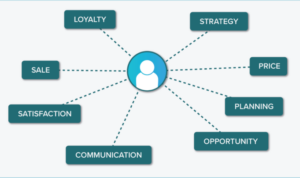Understanding Customer Retention dives into the core concepts of keeping customers loyal and satisfied, a vital aspect for any business looking to thrive in a competitive market.
From the importance of retaining customers to analyzing behavior patterns and implementing effective strategies, this topic offers valuable insights for long-term success.
Importance of Customer Retention
Retaining customers is crucial for business growth as it helps in building a loyal customer base that continues to generate revenue over time. By focusing on customer retention, businesses can benefit from repeat purchases, increased customer lifetime value, and positive word-of-mouth referrals.
Benefits of Focusing on Customer Retention
- Higher Customer Lifetime Value: Repeat customers tend to spend more than new customers, increasing the overall revenue for the business.
- Cost-Effectiveness: Acquiring new customers can be up to five times more expensive than retaining existing ones, making customer retention a more cost-effective strategy.
- Brand Loyalty: Loyal customers are more likely to choose your brand over competitors, leading to increased market share and sustainable growth.
Contribution to Long-Term Profitability, Understanding Customer Retention
- Stable Revenue Streams: Retained customers provide a consistent revenue stream, reducing the impact of fluctuations in the market.
- Upselling and Cross-Selling Opportunities: Existing customers are more receptive to additional products or services, leading to increased sales and profitability.
- Reduced Churn Rate: By focusing on customer retention, businesses can lower their churn rate and minimize the loss of customers to competitors.
Understanding Customer Behavior

Understanding customer behavior is crucial in improving retention rates for businesses. By analyzing how customers behave, companies can tailor their strategies to meet their needs and expectations, ultimately leading to higher customer satisfaction and loyalty.
Impact of Customer Behavior Patterns
Customer behavior patterns can significantly impact retention rates. For example, customers who regularly engage with a brand through purchases, reviews, and feedback are more likely to remain loyal. On the other hand, customers who only make one-time purchases or show little interest in the brand’s offerings may be at risk of churning.
- Regular Engagement: Customers who frequently interact with a brand are more likely to be retained as they have a strong connection to the business.
- Repeat Purchases: Customers who make repeat purchases demonstrate loyalty and trust in the brand, increasing their retention likelihood.
- Feedback and Reviews: Customers who provide feedback and positive reviews are valuable as they help improve the brand’s reputation and attract new customers.
- Inactivity: Customers who show signs of inactivity, such as not opening emails or visiting the website, may need re-engagement strategies to prevent churn.
Role of Data Analytics
Data analytics plays a vital role in understanding customer behavior. By analyzing customer data such as purchase history, browsing behavior, and demographics, businesses can gain valuable insights into their customers’ preferences and tendencies.
Data analytics allows businesses to segment customers based on their behavior, create personalized marketing campaigns, and predict future trends to enhance customer retention strategies.
Strategies for Customer Retention: Understanding Customer Retention
Customer retention is crucial for the long-term success of any business. Implementing effective strategies can help businesses keep their existing customers engaged and satisfied, leading to increased loyalty and repeat purchases.
Loyalty Programs
Loyalty programs are a popular retention strategy that rewards customers for their repeat business. These programs can include points systems, exclusive discounts, or special perks for loyal customers. By incentivizing customers to continue purchasing from the business, loyalty programs can help increase customer retention rates.
Personalized Communication
Personalized communication involves tailoring messages and offers to individual customers based on their preferences and past interactions with the business. By sending targeted emails, personalized recommendations, or special birthday offers, businesses can make customers feel valued and appreciated, leading to higher retention rates.
Exceptional Customer Service
Providing exceptional customer service is essential for retaining customers. By resolving issues promptly, going above and beyond to meet customer needs, and creating a positive overall experience, businesses can build strong relationships with their customers and increase loyalty.
Proactive vs. Reactive Strategies
Proactive retention strategies involve anticipating and addressing customer needs before they become problems. This can include reaching out to customers for feedback, offering proactive solutions, or providing personalized recommendations. On the other hand, reactive strategies involve responding to customer concerns or complaints after they arise. While reactive strategies are important for addressing immediate issues, proactive strategies are often more effective in preventing customer churn and building long-term loyalty.
Case Studies
One successful example of a customer retention strategy is Starbucks’ loyalty program, which offers rewards for frequent purchases and personalized offers based on customer preferences. This program has helped Starbucks build a loyal customer base and increase customer retention rates. Another example is Amazon’s proactive customer service approach, where they anticipate customer needs and address issues before they escalate, leading to high customer satisfaction and retention.
Measuring Customer Retention

Measuring customer retention is crucial for businesses to understand their customer loyalty and the effectiveness of their retention strategies. By tracking key metrics, businesses can make data-driven decisions to improve customer satisfaction and long-term relationships.
Key Metrics for Measuring Customer Retention
- Churn Rate: The percentage of customers who stop using a product or service within a given period. A high churn rate indicates low customer retention.
- Repeat Purchase Rate: The percentage of customers who make repeat purchases. A high repeat purchase rate signifies strong customer loyalty.
- Customer Lifetime Value (CLV): The total revenue a business can expect from a customer throughout their entire relationship. Understanding CLV helps businesses allocate resources effectively.
Importance of Tracking and Analyzing Metrics
Tracking and analyzing these metrics provide valuable insights into customer behavior, preferences, and satisfaction levels. By identifying trends and patterns, businesses can tailor their retention strategies to meet customer needs and expectations, ultimately leading to increased customer loyalty and revenue.
Utilizing Data for Improving Customer Retention
Businesses can leverage data analysis tools to segment customers based on their behavior and preferences. By personalizing marketing campaigns and offers, addressing customer concerns promptly, and providing exceptional customer service, businesses can enhance customer retention and foster long-term relationships.





